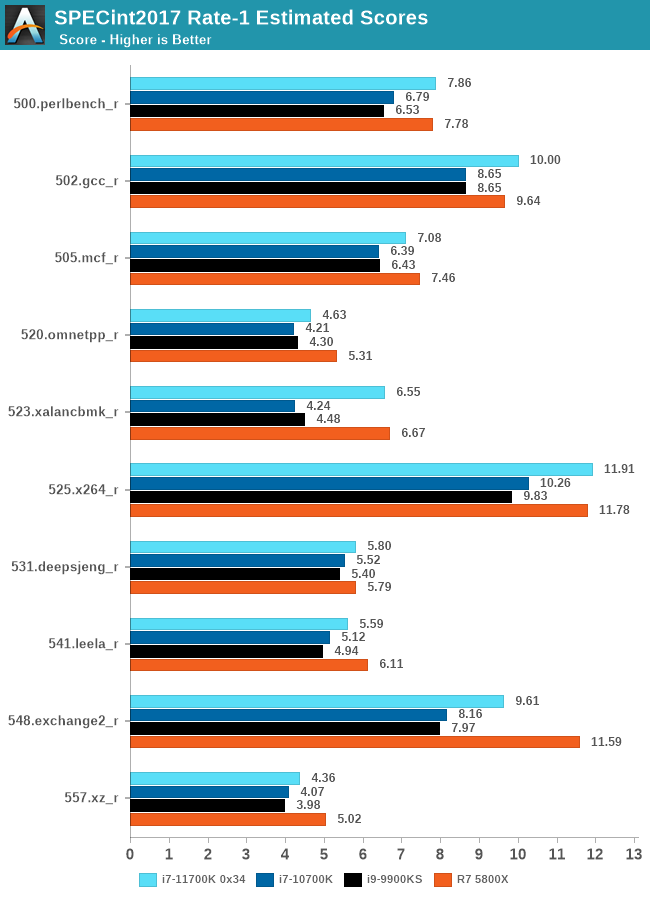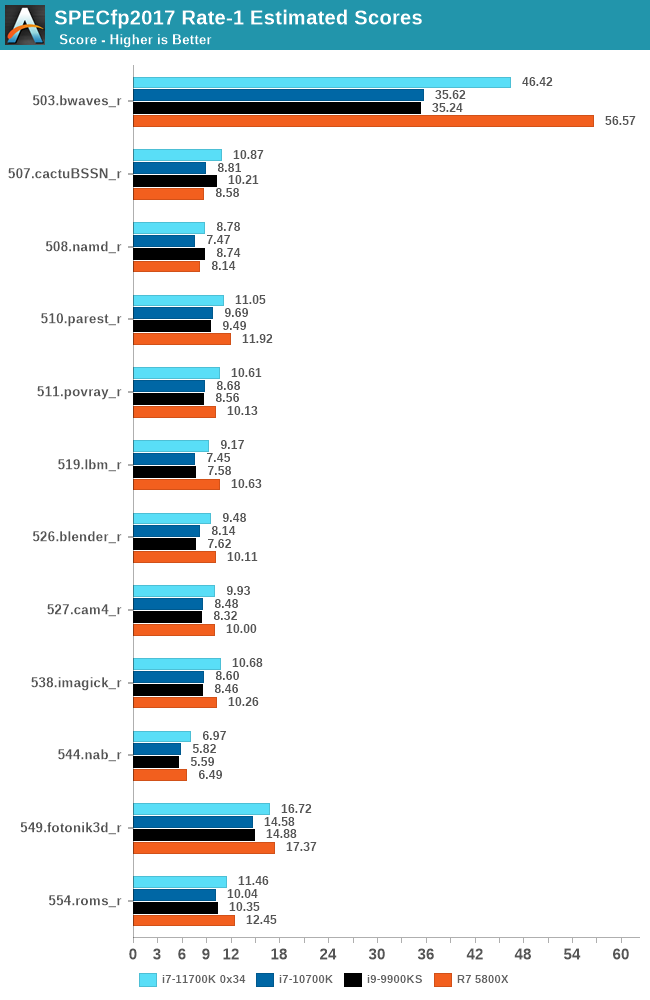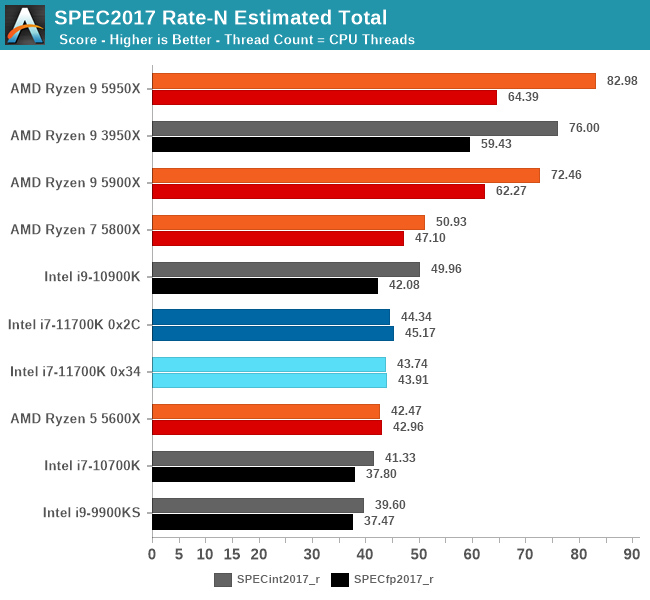Intel Core i7-11700K Review: Blasting Off with Rocket Lake
by Dr. Ian Cutress on March 5, 2021 4:30 PM EST- Posted in
- CPUs
- Intel
- 14nm
- Xe-LP
- Rocket Lake
- Cypress Cove
- i7-11700K
CPU Tests: SPEC
Page by Andrei Frumusanu
SPEC2017 is a series of standardized tests used to probe the overall performance between different systems, different architectures, different microarchitectures, and setups. The code has to be compiled, and then the results can be submitted to an online database for comparison. It covers a range of integer and floating point workloads, and can be very optimized for each CPU, so it is important to check how the benchmarks are being compiled and run.
We run the tests in a harness built through Windows Subsystem for Linux, developed by our own Andrei Frumusanu. WSL has some odd quirks, with one test not running due to a WSL fixed stack size, but for like-for-like testing is good enough. Because our scores aren’t official submissions, as per SPEC guidelines we have to declare them as internal estimates from our part.
For compilers, we use LLVM both for C/C++ and Fortan tests, and for Fortran we’re using the Flang compiler. The rationale of using LLVM over GCC is better cross-platform comparisons to platforms that have only have LLVM support and future articles where we’ll investigate this aspect more. We’re not considering closed-sourced compilers such as MSVC or ICC.
clang version 10.0.0
clang version 7.0.1 (ssh://git@github.com/flang-compiler/flang-driver.git
24bd54da5c41af04838bbe7b68f830840d47fc03)
-Ofast -fomit-frame-pointer
-march=x86-64
-mtune=core-avx2
-mfma -mavx -mavx2
Our compiler flags are straightforward, with basic –Ofast and relevant ISA switches to allow for AVX2 instructions. We decided to build our SPEC binaries on AVX2, which puts a limit on Haswell as how old we can go before the testing will fall over. This also means we don’t have AVX512 binaries, primarily because in order to get the best performance, the AVX-512 intrinsic should be packed by a proper expert, as with our AVX-512 benchmark. All of the major vendors, AMD, Intel, and Arm, all support the way in which we are testing SPEC.
To note, the requirements for the SPEC licence state that any benchmark results from SPEC have to be labeled ‘estimated’ until they are verified on the SPEC website as a meaningful representation of the expected performance. This is most often done by the big companies and OEMs to showcase performance to customers, however is quite over the top for what we do as reviewers.
For the new Cypress Cove based i7-11700K, we haven’t had quite the time to investigate the new AVX-512 instruction differences – since this is the first consumer desktop socketed CPU with the new ISA extensions it’s something we’ll revisit in the full review. Based on our testing on the server core counterparts however, it doesn’t make any noticeable differences in SPEC.

In the SPECint2017 suite, we’re seeing the new i7-11700K able to surpass its desktop predecessors across the board in terms of performance. The biggest performance leap is found in 523.xalancbmk which consists of XML processing at a large +54.4% leap versus the 10700K.
The rest of the improvements range in the +0% to +15% range, with an average total geomean advantage of +15.5% versus the 10700K. The IPC advantage should be in the +18.5% range.

In the FP scores, there’s nothing standing out too much, with general even improvements across the board. The total improvement here is +19.6%, with the IPC improvement in the +22% range.

Although the new Cypress Cove cores in the 11700K do have good generational IPC improvements, that’s all compared to the quite old predecessor, meaning that for single-thread performance, the advancements aren’t enough to quite keep up with the latest Zen3 competition from AMD, or for that matter, the Firestorm cores in Apple’s new M1.

More interesting are the multi-threaded SPEC results. Here, the new generation from Intel is showcasing a +5.8% and +16.2% performance improvement over its direct predecessor. Given the power draw increases we’ve seen this generation, those are rather unimpressive results, and actually represent a perf/W regression. AMD’s current 6-core 5600X actually is very near to the new 11700K, but consuming a fraction of the power.










541 Comments
View All Comments
Zoeff - Friday, March 5, 2021 - link
Now this is a welcome surprise!nandnandnand - Friday, March 5, 2021 - link
This is actually Intel's best product launch ever. Because you can buy it and get in on the class action lawsuit later.Zoeff - Friday, March 5, 2021 - link
To be clear, I was referring to the article itself.But yes the performance is also a surprise for me after going through the article. I expected a nice performance uplift, perhaps a bit faster than Ryzen 5000 but with a higher power draw as a trade off for being on the same Intel 14nm node still. Definitely did NOT expect it to be slower.
nandnandnand - Friday, March 5, 2021 - link
To be clear, I was replying to you to get a reply at the top of the comments. Completely self-serving manipulation of AnandTech's comment section.Hopefully, terroradagio is right and an update will improve performance and efficiency slightly. Also, I wonder how the 11900K will look going ~200-300 MHz above this.
barich - Friday, March 5, 2021 - link
I have a feeling that the additional power draw required to get that extra 2-300 MHz is going to be well out of proportion to the performance gained by it. This chip is already pushed past the edge just to not regress (usually) over the previous generation.whatthe123 - Friday, March 5, 2021 - link
Considering this chip is already drawing way too much power the 11900's are probably binned like crazy and run a much lower voltage. Even then it'll probably still use more power than the 11700k. I think they should've just accepted that 14nm was not going to work for this backport. There's a market for cometlake in gamers but what market is there for this? Niche scientific computing?terroradagio - Friday, March 5, 2021 - link
Games don't require the type of power people here are crying about. Honestly, do people just sit at their computers and run AVX benchmarks all day?barich - Friday, March 5, 2021 - link
You're still looking at like an 80W difference and a requirement for the best air cooling available if you don't want temps to be out of control. I might be willing to tolerate the extra power draw if I got more performance out of it, but that's not the case.eva02langley - Saturday, March 6, 2021 - link
You mean LIQUID COOLING at this point. You need a good AIO with such power requirements.JimmyTheFish - Friday, March 5, 2021 - link
No, power consumption is exactly as bad as people are "crying" about, this chips is a joke, hotter, slower and more expensive than even the quite Sub-Par cometlake chips on the market, nevermind the superb Zen 3 offerings, which are starting to see increased availability with the single CCD 6 and 8 core 5600X and 5800XTo even be remotely appealing the 10700K need to be cheap, sub $350 cheap, and thats just not gonna happen